I’m excited to share Lesson 3: Rain Fills the World with you! It tells the story of Noah and the flood (from Genesis 6-9) and focuses on short i with blends and digraphs. The activities are very similar to those in Lesson 1 & Lesson 2 to help build confidence and independence in your young reader.
*This is a series I originally posted YEARS ago on This Reading Mama. My goal is to revise it and add more to it. But for now, I’m just moving it to its new home here.
In this post, you’ll find:
-
-
-
my Rain Fills the World reader (with a focus on short i words)
-
printables & activities for reinforcing short i words with blends/digraphs
-
printables & activities to coincide with sight words (most are from Fry’s first 100 Sight Word & Pre-Primer/Primer lists)
-
writing ideas & prompts
-
Bible Verse activities
-
A lesson outline that gives a plan for spacing out the activities over the week
-
-
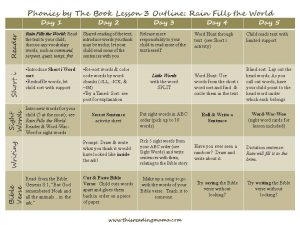
READER: Rain Fills the World
Before reading for the first time, I wrote down these words: sin, grim, & brim to discuss the meaning when I read the text. On subsequent days, I gave over more and more responsibility to him, like I did with the reader in Lesson 1 & Lesson 2.
SHORT I: If you like this sort, these are the same kind of sorts you’ll find in Words Their Way & all their supplement books. I highly recommend these!
Day 1:
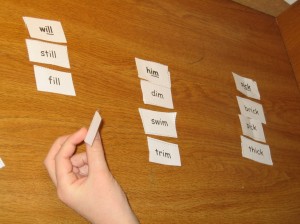 Short i word sort: We sorted the short i word families: -ick, -im, & -ill. I modeled first, reading each word, looking for the pattern, and he finished the sort. He read all the words after sorting. We scrambled them up and he resorted with support, then we took turns reading the words. Many of these words come from the reader.
Short i word sort: We sorted the short i word families: -ick, -im, & -ill. I modeled first, reading each word, looking for the pattern, and he finished the sort. He read all the words after sorting. We scrambled them up and he resorted with support, then we took turns reading the words. Many of these words come from the reader.
Day 2:
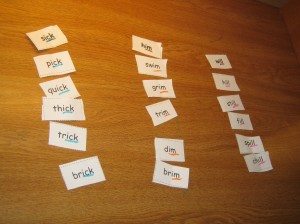 He resorted with support, then used a highlighter to find the patterns. Then, he read all the words.
He resorted with support, then used a highlighter to find the patterns. Then, he read all the words.
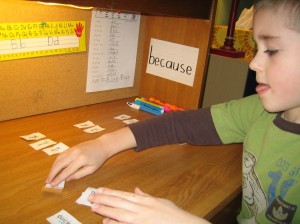 Next, we tried a timed sort. I put out the headers and he sorted them as quickly as he could while I timed him. I told him his time (in seconds) and asked him sort them again, trying to beat his own time. He wasn’t too fond of this at first, but once he realized I wasn’t going to let him out of it, he got into it. (Love the tongue sticking out!)
Next, we tried a timed sort. I put out the headers and he sorted them as quickly as he could while I timed him. I told him his time (in seconds) and asked him sort them again, trying to beat his own time. He wasn’t too fond of this at first, but once he realized I wasn’t going to let him out of it, he got into it. (Love the tongue sticking out!)
Day 3:
Little Words Activity with SPLIT. I cut apart the letters and mix them up so he doesn’t know what all the letters will spell.
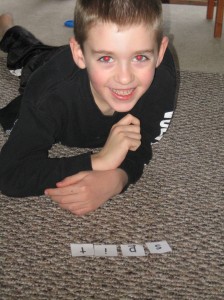 He makes little words, (he thought he was doing something “naughty” when I asked him to spell spit–I thought the red eyes needed to stay to go with the “naughtiness”), then he tries to figure out what word he’ll spell when he uses all the letters.
He makes little words, (he thought he was doing something “naughty” when I asked him to spell spit–I thought the red eyes needed to stay to go with the “naughtiness”), then he tries to figure out what word he’ll spell when he uses all the letters.
Day 4:
Word hunt with the short i word sort words. (We did this a little differently this week to change it up a bit and to integrate some writing.)
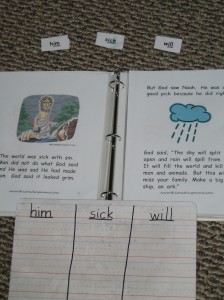 I pulled out all the head words from the Short i word sort: HIM, SICK, & WILL
I pulled out all the head words from the Short i word sort: HIM, SICK, & WILL
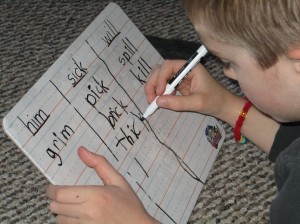 As we read through the book together, he looked for words within the text that would fit under these patterns (-ICK, -IM & -ILL) and wrote them down in column format.
As we read through the book together, he looked for words within the text that would fit under these patterns (-ICK, -IM & -ILL) and wrote them down in column format.
5. To see a blind sort in action, see Lesson 1 under Short a (also #5 in that post.)
SIGHT WORDS: (You can find a list of sight words for the lesson on the very first page of the Rain Fills the World Reader and word cards in the Word-Wac-Woe activity.)
I pulled come, could, open, and because to be ALuv’s sight words for the week. My suggestion is you also pull 2-5 new words out for your own child; but the majority of the words should already be familiar to him.
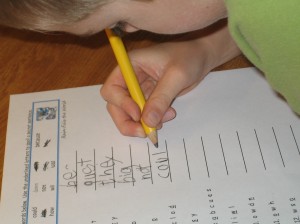 Secret Sentence: Unscramble the sight words to find the secret sentence: But God saw Noah. (Once the letters are written in the blanks, it helps to have the child read the sentence and ask him to figure out which letters should be capital letters.)
Secret Sentence: Unscramble the sight words to find the secret sentence: But God saw Noah. (Once the letters are written in the blanks, it helps to have the child read the sentence and ask him to figure out which letters should be capital letters.)
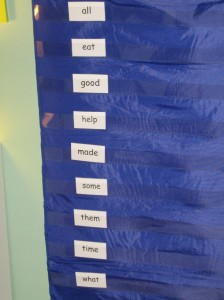 We used our pocket chart to put these words in ABC order. He puts in order, then reads them to me. If you want to integrate some writing, have your child write the words down on paper or a dry erase board when finished alphabetizing.
We used our pocket chart to put these words in ABC order. He puts in order, then reads them to me. If you want to integrate some writing, have your child write the words down on paper or a dry erase board when finished alphabetizing.
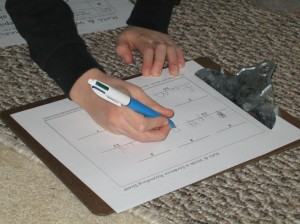 Roll & Write a Sentence: Roll 2 dice, add the sum, then use the number code to fill in the sentence. (2 pages in download)
Roll & Write a Sentence: Roll 2 dice, add the sum, then use the number code to fill in the sentence. (2 pages in download)
Word-Wac-Woe: (strategy resembles Tic-Tac-Toe)
Display and read through 15-20 of the sight word cards,
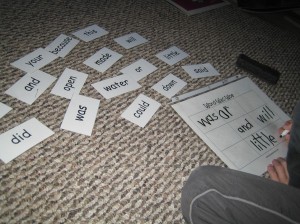 jot them down on your game board,
jot them down on your game board,
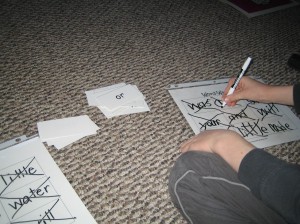 shuffle the cards and place them face-down in a pile. Players take turns reading the sight words and crossing them off their game boards. We usually play that whoever crosses off their entire game board wins–this makes the game last longer and more words are read. Directions are in the download as well.
shuffle the cards and place them face-down in a pile. Players take turns reading the sight words and crossing them off their game boards. We usually play that whoever crosses off their entire game board wins–this makes the game last longer and more words are read. Directions are in the download as well.
If you’ve already printed off all the words from Lesson 1 & 2, you only need to print off pages 8-11 of the download for Lesson 3’s words.
WRITING: Most of our writing this week was tied into our math and science lessons, so we didn’t do the writing prompts from my outline. To see some of the writing activities in action, look at Lesson 1 & Lesson 2.
BIBLE VERSE: More ideas are listed in the Lesson 3 Outline, but there is the printable for the Cut & Paste Bible Verse.
To download the zip file from this lesson, click below:
Enjoy learning to read with Bible stories!
~Becky
Find all the lessons in this Bible Series so far by clicking on the images below:
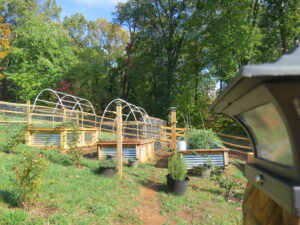
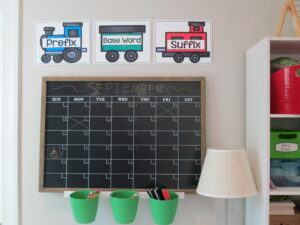
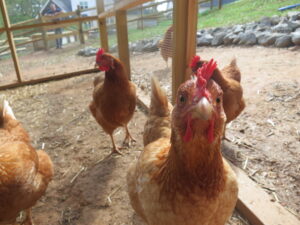


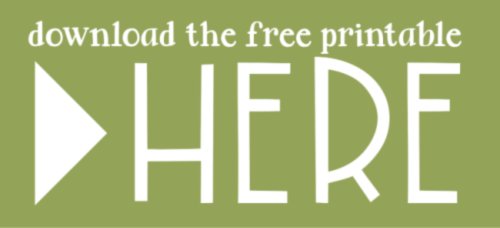
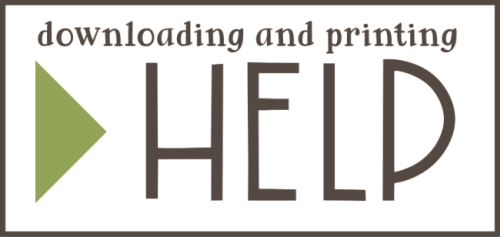
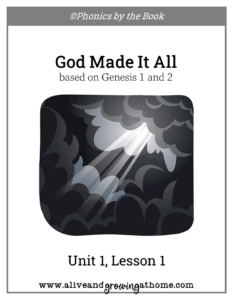
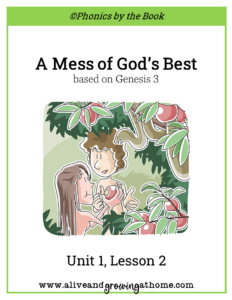
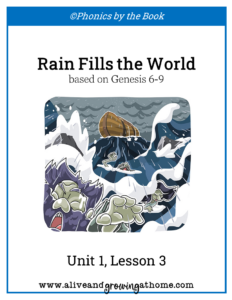
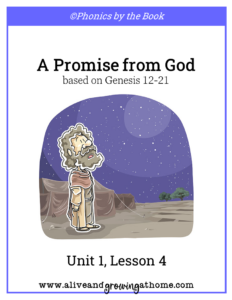
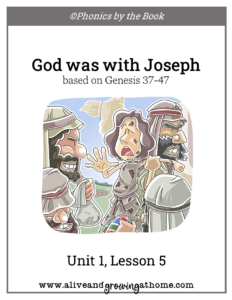
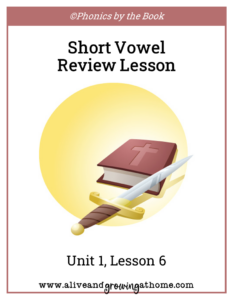
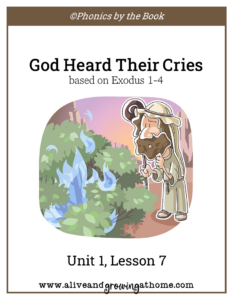
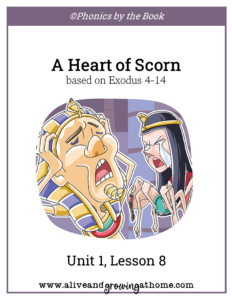
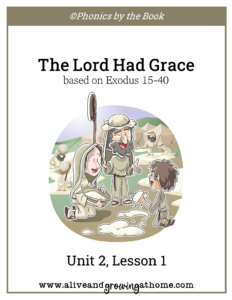
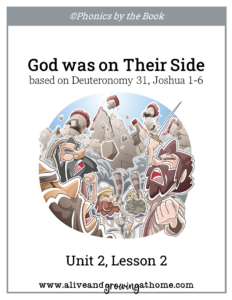
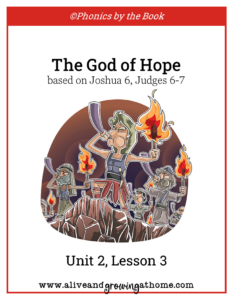
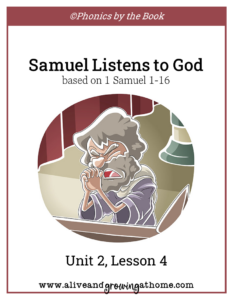

Leave a Reply